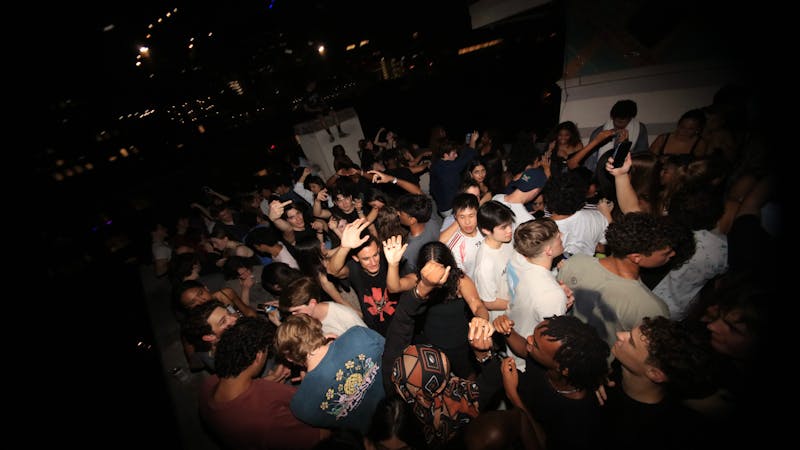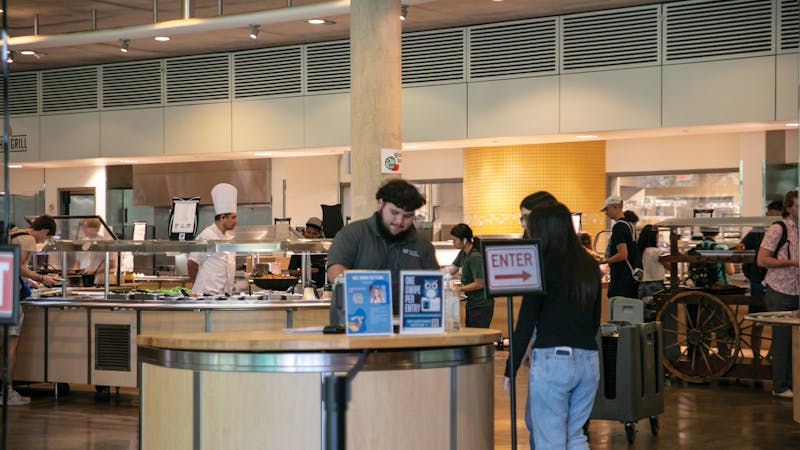Classes test SCALE-UP method
A new interactive teaching format known as SCALE-UP premiered in two Rice courses this semester and is set to expand to more classes next semester.
SCALE-UP stands for Student-Centered Active Learning Environment for Undergraduate Programs, and its primary aim is to involve students actively in the instructional process, Manager of Educational Technologies Carlos Solis said. Through this format, students interact with each other during class in addition to listening to the instructor's lecture.
Solis said the instructor leads student teams through a series of classroom exercises focused on discussion and sharing to help them learn. Traditional classroom furniture is substituted with round tables, and three teams of three students each sit at each table, according to Solis. The teams are provided with whiteboards where students outline ideas for problem-based learning and share their answers with others, he said.
"The basic idea behind this is that learning should be a very active process of engagement, discovery and collaboration," Solis noted.
SCALE-UP was piloted this semester in two Biochemistry & Cell Biology courses: BIOC 311: Advanced Experimental Biosciences and BIOC 211: Introduction to Experimental Biosciences, taught by Biochemistry & Cell Biology professors Beth Beason Abmayr and Elizabeth Eich, respectively. The classes are held in the commons of Jones College.
Solis said Educational Technologies focused on college commons when looking for appropriate locations for the program because they already had the proper seating arrangement. SCALE-UP required flat spaces, and the auditorium style of Rice's large classrooms prevented them from being reconfigured, he noted. He said that, in the end, the Jones College commons proved to be the best location for the pilot.
Educational Technology then installed various technological enhancements in the commons, including a high-lumen projector, multipoint audio, connectivity plates for computers and clicker technologies.
Abmayr said the new SCALE-UP format has impacted her class positively. Rather than lecture to the students, she said she walked around during class, interacting with each group and employed additional learning activities like clicker questions, demonstrations, reflective writing and student presentations.
"After just two class meetings using SCALE-UP, the outcomes exceeded my expectations," Abmayr said. "The majority of students were enthusiastic about the collaborative classroom environment, and overall, the students seemed better prepared for lab after interacting with their teammates in class."
The students worked more efficiently, were more confident, and seemed to enjoy the lecture and lab more, Abmayr noted. However, she cited a lack of lecture time and the distracting noise level in the commons as drawbacks to the format.
"Since we use class time to discuss the lab and work on calculations, there is not enough time for lectures on biochemistry theory and experimental background," Abmayr said. "Students who did not study the material before coming to class did not participate in round table discussions and were not as prepared for lab later during the week."
Still, Abmayr said she was satisfied with the SCALE-UP approach and would continue to promote and use it for BIOC 311 in the spring with the hopes of becoming even more student-centered.
Baker College junior Lyahn Hwang, who is a student in BIOC 311, said she appreciated the SCALE-UP format and found it more engaging.
"In previous labs, the pre-lab discussions were lectures by the professor, and I don't think they improved our learning," Hwang said. "Ever since [Abmayr] chose to implement this more interactive set-up for pre-labs, there were fewer students passed out, and the hour seemed to go by faster."
Fellow instructor Eich added that she had used some active learning techniques in a traditional lecture room, but they were more effective in the SCALE-UP format. She cited students answering questions with individual clickers as an example. Group discussions improved the percentage of correct answers to these questions.
"This highlights two important aspects of SCALE-UP: discussion promotes understanding, and feedback is immediate for both student and instructor," Eich noted. "How many instructors can say that they walk out of class knowing whether students understood the material?"
SCALE-UP was first championed by Robert Beichner at North Carolina State University and was started at Rice when Dean of Undergraduates John Hutchinson brought Beichner to Rice for a Scientia seminar in February 2011. Beichner's SCALE-UP presentation sparked enough interest among the faculty to facilitate the program's three-month development and launch, Solis said.
He added that the program has not had any serious challenges so far, but he anticipates the conversion of existing classrooms into SCALE-UP format as the biggest future obstacle.
"Because of their geometry and configuration, SCALE-UP classrooms cannot seat as many students as traditional classrooms," Solis noted. "With increased enrollment, there will be a natural tension between these two aspects."
Converting an existing podium classroom into a SCALE-UP space – which includes installing new furniture, replacing traditional seats with round tables and chairs, and buying small whiteboards – could incur 10 to 12 percent in additional costs, Solis said.
However, Solis said the assessment data Education Technologies collected about the program has indicated generally positive student attitudes toward it, and they have identified at least eight other faculty members interested in SCALE-UP.
He added that Educational Technologies is looking into combining SCALE-UP with the OWL-Socrates system to provide more review materials to help students prepare for the teamwork that happens in a SCALE-UP classroom.
Solis said Rice was not the only school developing a SCALE-UP program. Schools like MIT, Clemson University, the University of Minnesota, Florida Gulf Coast University and the University of Wisconsin have also adopted the new format, he noted.
More from The Rice Thresher

Dis-O, move-in weekend see increase in alcohol transports from last year
Rice’s first wet weekend of the year saw four times as many calls for intoxication-related transports of students to the hospital compared to the previous three years, according to emails sent out by college presidents and chief justices.

On-campus meal plan changed to unlimited swipes
Housing and Dining recently revealed a new dining plan for the upcoming semester. The required on-campus meal plan now has unlimited meal swipes, compared to 375 meal swipes last year. H&D said the previous on-campus meal plan was for students who intended to eat on campus 15 to 25 meals a week.

Rice Stadium student section relocated
The Rice Stadium student section has been relocated to sections 106 and 107, according to an announcement from Rice Athletics on X.

Please note All comments are eligible for publication by The Rice Thresher.